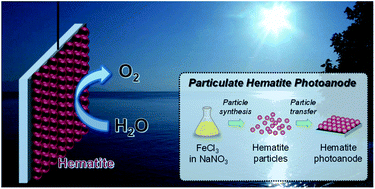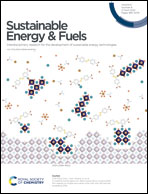Hematite photoanodes prepared by particle transfer for photoelectrochemical water splitting†
Abstract
A hematite (α-Fe2O3) photoanode for O2 evolution is usually prepared as a thin film on a conductive substrate like a fluorine-doped tin oxide/glass. Such a conductive substrate is not resistive to a temperature as high as 800 °C, while this temperature is required to remove the surface states on α-Fe2O3. In this study, we solved this issue by preparing α-Fe2O3 particles at first and then applying them to photoanodes by particle transfer. The optimized particulate α-Fe2O3 photoanode showed a photocurrent of only ∼0.3 mA cm−2 at 1.23 V (versus a reversible hydrogen electrode), but it showed a surprisingly low onset potential at 0.6 VRHE at pH 7.2. It was therefore combined with a particulate Ga-doped La5Ti2Cu0.9Ag0.1O7S5 photocathode in a parallel cell for unbiased water splitting, showing a solar-to-hydrogen conversion efficiency of 0.07%. Our study presents an alternative approach for preparing a α-Fe2O3 photoanode and verifies its potential for cost-effective unbiased water splitting.



 Please wait while we load your content...
Please wait while we load your content...